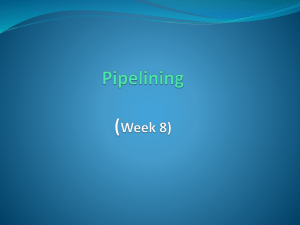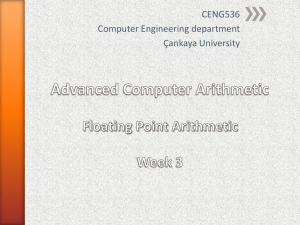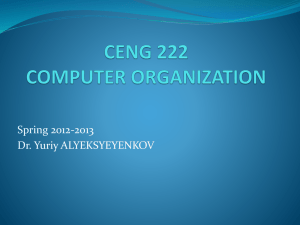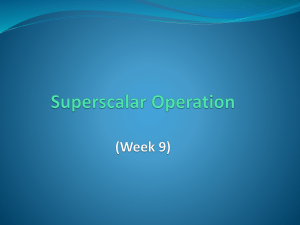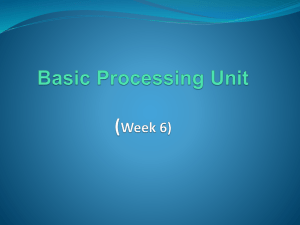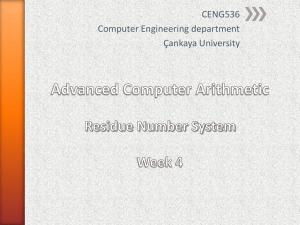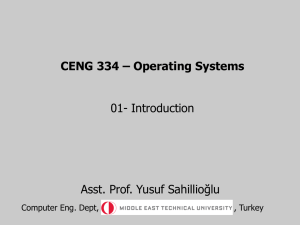PPP 2
advertisement
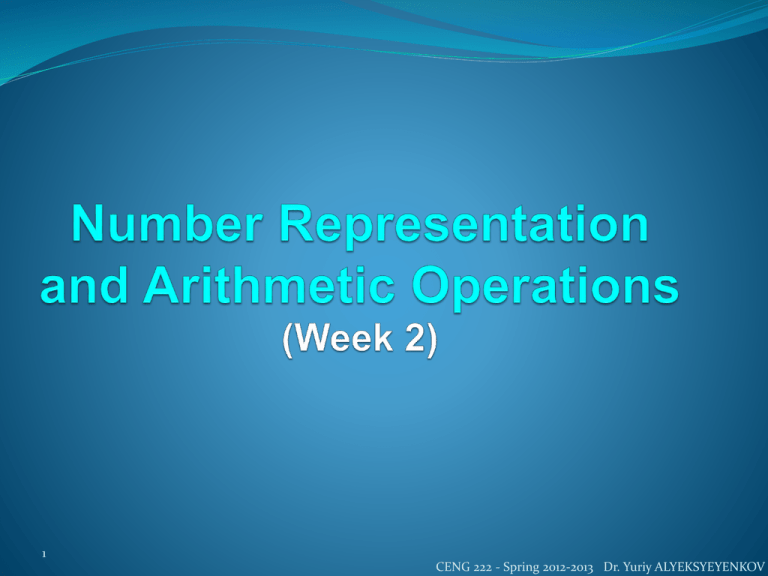
1 CENG 222 - Spring 2012-2013 Dr. Yuriy ALYEKSYEYENKOV Computers are built using the logic circuits that operate on information represented by two-valued electric signals. We label the two values as “0” and “1”, and we define amount of information represented by such a signal as a bit of information, where bit stands for binary digit. The most natural way to represent a number in a computer system is by a string of bits called a character code. Number representation. Consider an n-bit vector B = bn−1 . . . b1b0 where bi = 0 or 1 for 0 ≤ i ≤ n − 1. This vector can represent an unsigned integer value V(B) in the range 0 to 2n − 1, where V(B) = bn−1 × 2n−1 +・ ・ ・+b1 × 21 + b0 × 20 We need to represent both positive and negative numbers. Three systems are used for representing such numbers: • Sign-and-magnitude • 1’s-complement • 2’s-complement 2 CENG 222 - Spring 2012-2013 Dr. Yuriy ALYEKSYEYENKOV In all three systems, the leftmost bit is 0 for positive numbers and 1 for negative numbers. Positive values have identical representations in all systems, but negative values have different representations. Lets analyze four bit numbers. In the sign-and-magnitude system, negative values are represented by changing the most significant bit (b3) from 0 to 1 in the B vector of the corresponding positive value. In 1’s-complement representation, negative values are obtained by complementing each bit of the corresponding positive number. For n-bit numbers, this operation is equivalent to subtracting the number from 2n − 1. In the 2’s-complement system, forming the 2’s-complement of an n-bit number is done by subtracting the number from 2n. Hence, the 2’s-complement of a number is obtained by adding 1 to the 1’s-complement of that number. 3 CENG 222 - Spring 2012-2013 Dr. Yuriy ALYEKSYEYENKOV 4 CENG 222 - Spring 2012-2013 Dr. Yuriy ALYEKSYEYENKOV Number Representation The sign-and-magnitude system seems the most natural, because we deal with sign-and-magnitude decimal values in manual computations. The 1’s-complement system is easily related to this system, but the 2’s-complement system may appear somewhat unnatural. However, we will show that the 2’scomplement system leads to the most efficient way to carry out addition and subtraction operations. It is the one most often used in modern computers. 5 CENG 222 - Spring 2012-2013 Dr. Yuriy ALYEKSYEYENKOV Decimal to Binary Transform Example: 117 2 Decimal -10 58 number 117 17 - 4 - 16 18 1 - 18 0 2 29 -2 9 -8 1 2 14 - 14 0 2 7 -6 1 2 3 2 -2 1 1 LSB (Least Significant Bit) MSB (Most Significant Bit) 1110101 6 CENG 222 - Spring 2012-2013 Dr. Yuriy ALYEKSYEYENKOV Binary to Decimal Transform For this transform is good to memorize set of powers of two numbers: Refers to memory: 7 20 = 1 21 = 2 22 = 4 23 = 8 24 = 16 25 = 32 26 = 64 27 = 128 28 = 256 29 = 512 210 = 1024 220 = 1 MB 230 = 1 GB KB (Kilo Byte) (Mega Byte) (Giga Byte) CENG 222 - Spring 2012-2013 Dr. Yuriy ALYEKSYEYENKOV Binary to Decimal Transform Example: Binary number 01110101 = 0×27 + 1×26 + 1×25 + 1×24 + 0×23 + 1×22 + 0×21 + 1×20 = 0×128 + 1×64 + 1×32 + 1×16 + 0×8 + 1×4 + 0×2 + 1×1 = 64 + 32 + 16 + 4 + 1 = 117 Decimal number 117 8 CENG 222 - Spring 2012-2013 Dr. Yuriy ALYEKSYEYENKOV Octal and Hexadecimal Systems Octal system. Binary number is divided by groups of three bit each. Each group is presented by decimal digit from 0 to 7. Example: 101 001 010 111 110 001 5 1 2 7 6 1 Hexadecimal system. Binary number is divided by groups of four bit each. For coding are used digits from 0 to 9. Additional digits are A=10, B=11, C=12, D=13, E=14, F=15. Example: 1010 0101 0001 1110 1100 0011 A 5 1 E C 3 9 CENG 222 - Spring 2012-2013 Dr. Yuriy ALYEKSYEYENKOV Addition of the Positive Numbers: In order to add multiple-bit numbers, we use a method analogous to that used for manual computation with decimal numbers. We add bit pairs starting from the low-order (right) end of the bit vectors, propagating carries toward the high-order (left) end. The carry-out from a bit pair becomes the carry-in to the next bit pair to the left. The carry-in must be added to a bit pair in generating the sum and carry-out at that position. 10 CENG 222 - Spring 2012-2013 Dr. Yuriy ALYEKSYEYENKOV Addition and Subtraction of Signed Numbers: Example: (+7) + (-3) = (+4) (+7) (-3) 0111 1011 (SM) 1100 (1’s) 1101 (2’s) Direct transform of 1 1 0 1 to unsigned decimal gives 1×23+1×22+0×21+1×20 = 13 To understand 2’s-complement arithmetic, consider addition modulo N (abbreviated as mod N). Consider the case N = 16, shown in the figure. 11 + 1 01 1 1 1 101 0100 +4 Carry-out bit CENG 222 - Spring 2012-2013 Dr. Yuriy ALYEKSYEYENKOV Addition and Subtraction of Signed Numbers: Example: (-6) + (+5) = (-1) (+5) (-6) 0101 1110 1001 1010 (SM) (1’s) (2’s) Locate 1 0 1 0 on the circle in Figure. Then move 0 1 0 1 (5) steps in the clockwise direction to arrive at 1 1 1 1, which yields the correct answer of -1. 1010 + 0101 0 1111 -1 Carry-out bit 12 CENG 222 - Spring 2012-2013 Dr. Yuriy ALYEKSYEYENKOV Addition and Subtraction of Signed Numbers: To add two numbers, add their n-bit representations, ignoring the carry-out bit from the MSB position. The sum will be the algebraically correct value in 2’scomplement representation if the actual result is in the range−2n−1 through +2n−1 − 1. To subtract two numbers X and Y , that is, to perform X − Y , form the 2’s-complement of Y , then add it to X using the add rule. Again, the result will be the algebraically correct value in 2’s-complement representation if the actual result is in the range −2n−1 through +2n−1 − 1. 13 CENG 222 - Spring 2012-2013 Dr. Yuriy ALYEKSYEYENKOV Overflow and Sign Extension Overflow: When answers do not fall within the representable range, we say that arithmetic overflow has occurred. We add additional bits to extend range of numbers. Sign Extension: We often need to represent a value given in a certain number of bits by using a larger number of bits. For a positive number, this is achieved by adding zeroes to the left. For a negative number in 2’s-complement representation, the leftmost bit, which indicates the sign of the number, is a 1. A longer number with the same value is obtained by replicating the sign bit to the left as many times as needed. 14 CENG 222 - Spring 2012-2013 Dr. Yuriy ALYEKSYEYENKOV Sign Extension Example: Positive number 0 1 0 1 1 0 0 1 0 0 0 0 0 0 0 0 0 1 0 1 1 0 0 1 Negative number Sign 1 0 0 0 1 1 1 0 1 1 1 1 1 1 1 1 1 0 0 0 1 1 1 0 15 CENG 222 - Spring 2012-2013 Dr. Yuriy ALYEKSYEYENKOV Overflow in Integer Arithmetic Using 2’s-complement representation, n bits can represent values in the range −2n−1 to +2n−1 − 1. For example, the range of numbers that can be represented by 4 bits is −8 through +7, as shown before. When the actual result of an arithmetic operation is outside the representable range, an arithmetic overflow has occurred. When adding unsigned numbers, a carry-out of 1 from the most significant bit position indicates that an overflow has occurred. However, this is not always true when adding signed numbers. For example, let’s us add 2’s-complement representation for 4-bit signed numbers. 16 CENG 222 - Spring 2012-2013 Dr. Yuriy ALYEKSYEYENKOV Overflow in Integer Arithmetic For example, using 2’s-complement representation for 4-bit signed numbers, if we add +7 and +4, the sum vector is 1011, which is the representation for −5, an incorrect result. In this case, the carry-out bit from the MSB position is 0. If we add −4 and −6, we get 0110 = +6, also an incorrect result. In this case, the carry-out bit is 1. Hence, the value of the carry-out bit from the sign-bit position is not an indicator of overflow. (Operations in 2’s complement system) +7 +4 Negative ! 17 01 1 1 + 0100 10 1 1 (-5) -4 -6 Carry-out bit Positive ! 1 1100 + 1010 0110 (+6) CENG 222 - Spring 2012-2013 Dr. Yuriy ALYEKSYEYENKOV Overflow in Integer Arithmetic 1 These observations lead to the following way to detect overflow when adding two numbers in 2’s-complement representation. 1. Examine the signs of the two summands and the sign of the result. When both summands have the same sign, an overflow has occurred when the sign of the sum is not the same as the signs of the summands. 2. When subtracting two numbers, the testing method needed for detecting overflow has to be modified somewhat; but it is still quite straightforward. 18 CENG 222 - Spring 2012-2013 Dr. Yuriy ALYEKSYEYENKOV Overflow in Integer Arithmetic 2 Another method of overflow detecting is based on analysis of carry-in signal to sign bit and carry-out signal from sign bit. (Operations in 2’s complement system) +7 +4 01 1 1 -4 1100 + 0100 -6 + 1010 10 1 1 Carry-out bit 1 0110 Negative ! (-5) Positive ! (+6) If carry-in present but carry-out absent, or no carry-in but there is carry-out, there is the overflow! It may be described as 19 CENG 222 - Spring 2012-2013 Dr. Yuriy ALYEKSYEYENKOV Character Representation The most common encoding scheme for characters is ASCII (American Standard Code for Information Interchange). Alphanumeric characters, operators, punctuation symbols, and control characters are represented by 7-bit codes. It is convenient to use an 8-bit byte to represent and store a character. The code occupies the low-order seven bits. The high-order bit is usually set to 0. Note that the codes for the alphabetic and numeric characters are in increasing sequential order when interpreted as unsigned binary numbers. This facilitates sorting operations on alphabetic and numeric data. MSB (Most Significant Bit), which increase range of numbers, is used in representation of symbols of different national languages. 20 CENG 222 - Spring 2012-2013 Dr. Yuriy ALYEKSYEYENKOV Character Representation 21 CENG 222 - Spring 2012-2013 Dr. Yuriy ALYEKSYEYENKOV
